We independently evaluate all recommended products and services. Any products or services put forward appear in no particular order. If you click on links we provide, we may receive compensation.
It’s always remarkable how initial impressions can change once you actually start to use something. Take the Kizer Theta and the Minitherium, both of which Kizer sent to me at the same time for reviews. I had been interested in the Theta – it seemed like it was a good blend of style and function for an EDC folder – and Kizer’s PR people asked if was interested in the new Minitherium as well. I looked at a few pictures of it and thought to myself, “what a willfully bizarre knife. How useful can this possibly be?” But nothing ventured, nothing gained – right?

Key Specs: Kizer Minitherium
The Minitherium is a miniaturized version of the Kizer Megatherium, both of which are designed by Elijah Isham (who also penned the Theta.) It retails for ~$200 (at time of writing) and has a 3” blade, stretches out 7.10” overall and weighs in at only 2.96 ounces. Compared to the original it’s about an inch and a half shorter overall and a half inch less blade. It’s also about half the weight and $40 cheaper.
The Blade
The Minitherium’s blade is bizarre, seemingly unrelated to the handle like they were designed by two separate design committees on first impression – it’s broad and rounded, in contrast with the handles sharp curves and peaks. It’s a dramatic modified wharncliffe shape, and modified is being modest here. It does have a bit of a curve to the sharpened edge, and the spine has a long rounded plunge to the tip with a false swedge that transitions into a concave thumb ramp on the top.
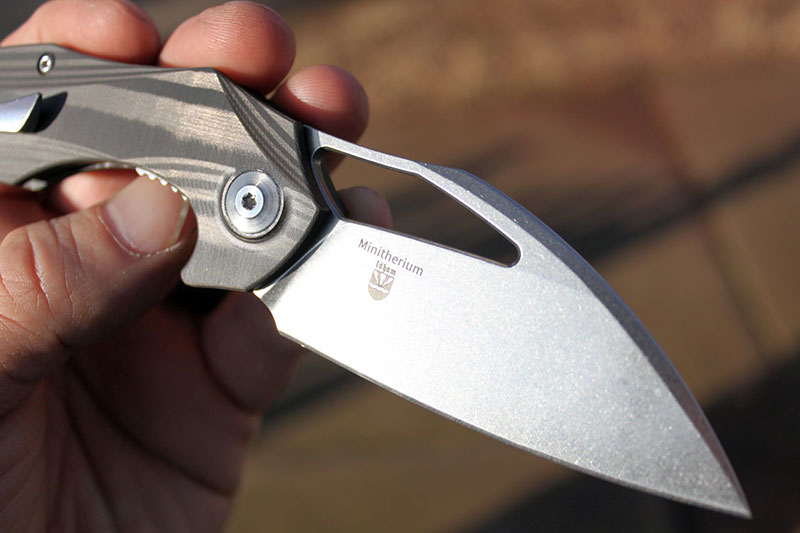
Blade stock is reasonably thin at 0.12”, and Kizer went with a very tall flat grind on the primary bevel to maximize performance. That primary bevel runs parallel with the bottom of the oblong thumb hole before it transitions into a diagonal plunge line, which cuts parallel with the leading edge of the handle. The blade measures in right at 3” long, ideal length for an EDC folder – a good balance between capability and manageable size.
Blade steel is Crucible CPM-S35VN, like most other Kizer models above the Vanguard line. S35VN was designed specifically for cutlery use with input from Chris Reeve Knives – who know a thing or two about steel – and is an improvement on CPM-S30V. Slight changes to its chemical composition make it easier to machine and sharpen and tougher (less prone to chipping) without sacrificing any edge retention or corrosion resistance. It has a stonewash finish here to resist corrosion.
Deployment and Lockup
The Minitherium was designed by Elijah Isham, and it features his “Edge Below Tab” design that places the flipper tab low and forward in the closed position – with the handle cut away for access – and places the tab tucked in the handle out of the way when it’s open. The tab placement is weird, but I get the concept – in both the closed and open positions the tab doesn’t protrude from the profile of the handle so it doesn’t get in your way when you’re cutting or when it’s in your pocket.

Like the Theta, the Minitherium flips on ceramic caged bearings that ride on special shaped steel washers. These washers fit in between the bearings and the carbon fiber scales to prevent wear – I’m sure ceramic bearings would quickly do a number on carbon fiber. The action on the Minitherium is much better than it was on the Theta – although they both have fairly light detents, the Minitherium seems to have less drag from the detent and using the flipper like a push-button will deploy the knife reliably almost every time. The knife has a large thumb hole but it’s difficult to use from both sides: the hook that forms the finger choil obstructs your thumb moving forward from the front, and also gets in the way of your middle finger from the rear – but the detent is light enough to open it either way. Moving your finger further back on the thumb hole makes it easier to get open, but it’s counter-intuitive.
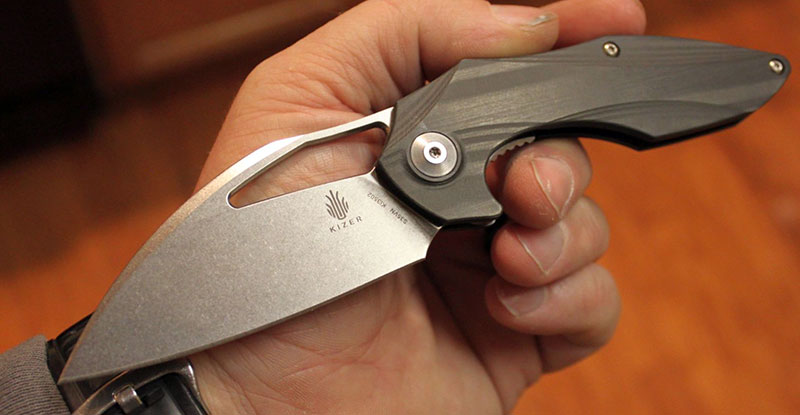
Lockup is via a simple stainless liner lock, which is thin but effective – it engages early at the far edge of the blade tang, and leaves no vertical or horizontal blade play even after the knife was disassembled for cleaning. Ergonomics of the lock are good – the portion that your thumb touches is slightly raised and has jimping for traction, and the section opposite the lock on the show side is slightly cut away to give you more room to disengage it. Liner locks may not get the fanboy adoration that titanium framelocks with steel bolt-on inserts do, but they’re simple and in my experience they’re less troublesome.
Features, Fit & Finish
This is where the Minitherium shines, much like the Theta. The materials in this knife are just so cool. The handles are the big conversation piece- full carbon fiber (not a G10 laminate, but real carbon fiber) is cut away in flowing shapes to contour the handles, and it creates a fascinating visual effect where it shows the grain of the material in varying widths and shapes. It’s smooth to the touch, without feeling over-epoxied like carbon fiber used to, offering some built-in grip.
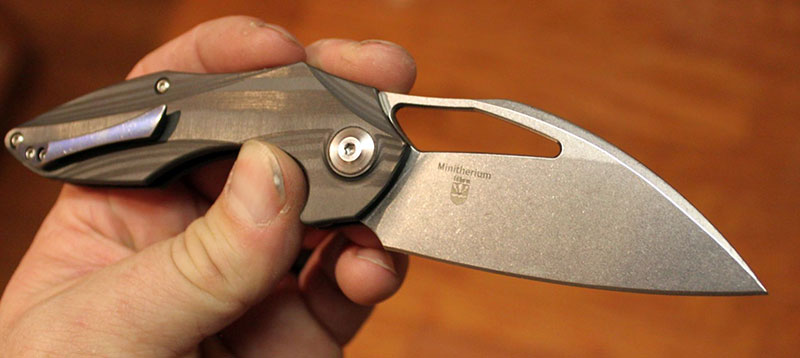
Like the Theta (as well as the Feist and many other new Kizer products) the Minitherium has the revised pivot hardware which is both less goofy looking and also less prone to stripping out when you go to loosen it – win-win. Further visual interest is added by a machined titanium pocket clip (right hand tip up carry only) and a flush fitting machined back spacer, both anodized a light blue color to provide some contrast. The blade is pretty broad which makes all the markings on it seem reasonable: the Kizer logo along with a model number and steel designation on the show side, and Isham’s logo and the name of the knife on the lock side are etched in place, giving you information without being a billboard.
Construction is pretty normal for Kizer – the pivot is a Chicago style screw with a tube on one end and a screw on the other. The pivot isn’t keyed to the frame, so you do have to hold it with one bit driver while you turn the other side if you’re disassembling it. Both pivot screws are Torx T8, and the body screws (4, which thread into the back spacer) and clip screws (2) are Torx T6, so no proprietary tools are required. The Minitherium has stainless liners which are skeletonized on the show side to save a little weight.
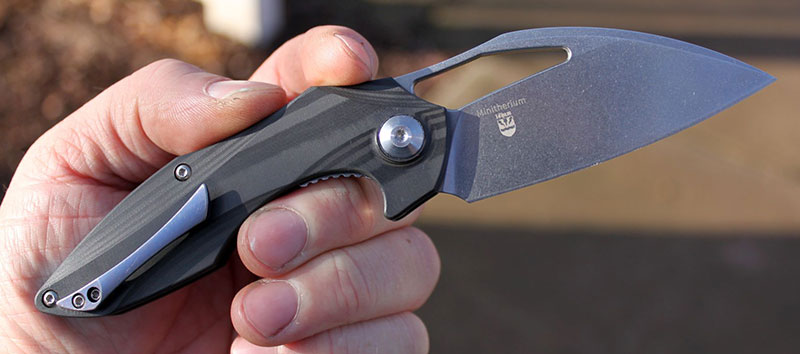
Fit and finish is pretty much what you’d expect of a high-end knife around the $200 price point – very good, with a few minor complaints. I do wish Kizer would go a few steps further with their factory edges, maybe using a higher grit belt and spending a little more time like Hogue does to get their knives sharper – but that’s why we have knife sharpeners, and the edge bevel was clean and level, so no complaints in that department. The handles are what steal the show and they’re beautifully made. I did notice that the anodization on the clip and backspacer started to show wear pretty rapidly. Fitment of the backspacer towards the end isn’t as flush as it is on the top either – not that it impacts use.
Field Test
The Minitherium is lighter than it looks, and it carries that way – never really weighing your pocket down. It does take up some pocket real estate because of the broad profile right behind the pivot, but the forward mounted flipper tab minimizes that to a certain extent. Like a lot of knives, that machined titanium clip is great to look at but not great as a clip compared to a regular old bent spring clip – the broad contact point and high tension with a steep approach angle make it hard to slide in your pocket, especially with thick seams. Once it’s in it won’t slide out accidentally, but it does pivot around a bit – these Batman looking clips still seem like a triumph of form over function.

It also provides the only real ergonomic headache – or hand-ache, more accurately, of the Minitherium. The tip of the clip comes to an unusually sharp point, most noticeable when you’re closing the knife or if you put your ring finger on it to brace the knife when opening. There’s nothing stopping you from hitting it with a little sand paper or a fine grit file to smooth it out, of course, but it would mess up the anodization and you really shouldn’t have to. Having a sharp point on the clip doesn’t provide any benefit.
The shape of the handle – that super deep finger choil, the sloping spine, the long thumb ramp – force your hand into one of two positions. Either a solid four finger grip with your thumb on the spine for push cutting, or a pinch grip with your thumb and middle finger on the pivot and your index finger on the spine for trimming or cutting packaging. The modified wharncliffe is designed for the latter kind of work, with the downward angled blade forcing itself into what you’re cutting and Isham’s “Edge below tab” design” keeping the flipper out of the way. This knife seems like a very expensive box cutter, and I mean that nicely – the geometry is reminiscent of a utility knife. Using a full grip with your finger in the choil and the knife laid on its side lets you slice horizontal packaging easily, with the blade curving forward.
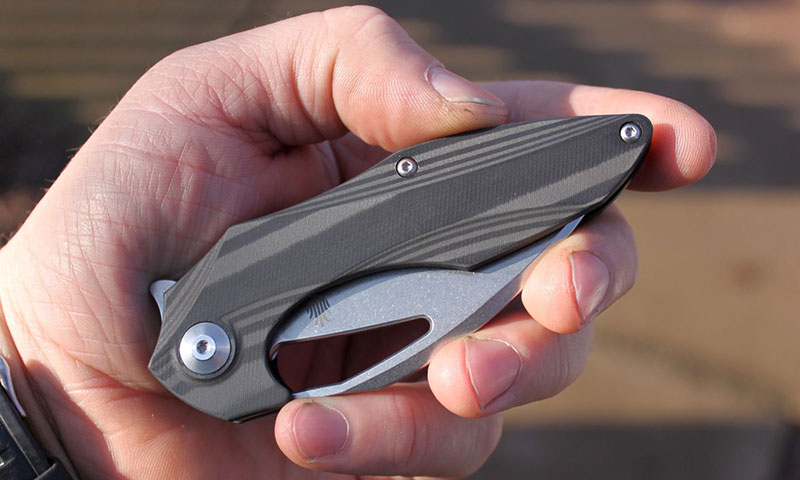
Maintenance on the Minitherium is easy, outside of needing a third arm to loosen the pivot screw with two bit drivers at once – we all have our tricks, though. Kizer seems to have taken some of their consumer complaints to heart – things that used to cause problems like soft body screws or galling and wear on the bearing contact washers are no longer issues. It does suffer from some grit buildup in the bearing cartridges, not an unusual condition that can be cured with some compressed air and oil. The straight blade profile makes sharpening easy as well.
Alternatives
All these knives available at BladeHQ.
There are plenty of interesting knives to choose from around the $200 price point. This knife competes with the Isham-designed Kizer Theta, and despite the Theta’s full-titanium construction and clean, simple lines the Minitherium is the clear choice thanks to its better action, ergonomics, and lighter weight.
If you like the carbon fiber handle and funky chunky aesthetics, the Zero Tolerance 0456CF sprint run would have been the one to get. It lightens up the heavy full titanium 0456 by 1.7 ounces (down to 4.9) but still packs a broad 3.25” sheepsfoot blade in CPM-20CV premium steel. It also has a stonewashed titanium lock side scale and a funky decorative pivot. This Dmitry Sinkevich designed knife was a sprint run from ZT (so it’s hard to find) and pricey too: $260 retail.

It’s hard to ignore the allure of the Giant Mouse brand, a joint effort between Jens Anso and Jesper Voxnaes, with production of the knives outsourced to an unnamed brand in Italy (hint: it’s Viper Tecnocut). While their high-end range constitutes full titanium handles, the ACE line uses lighter materials to get the weight and the price down. The ACE Biblio is a reimagined GM1, but with contoured carbon fiber handle scales and a 2.9” flat ground drop point in Bohler M390. It also has other goodies like a deep carry wire clip (that’s reversible tip down carry) and a ball bearing pivot with a flipper tab. It’s $190 retail, right in the ballpark of the Kizer – although Kizer’s build quality is generally much more predictable than Viper.

Another charming Italian that’s all carbon fiber is the Fox Knives Suru CF, which won Knife of the Year at Blade Show 2018. It’s also a Vox design, but smaller – a 2.32” blade and only 2.1 ounces in carbon fiber trim. It also uses Bohler M390 steel – which has better performance than S35VN, at the expense of higher cost and sharpening difficulty. What’s fascinating is that this isn’t just a carbon fiber scale – the whole frame including the lock bar is carbon fiber – of course, with a bolted in steel insert. It of course flips on bearings and also includes a machined pocket clip with a large roller bearing making it easier to slide into your pocket. It’s pricey at $270 retail but it’s a fascinating knife.

Finally, there’s the almost-too-pretty-to-use Spyderco Native 5 in fluted carbon fiber. It’s got the same handles from Spyderco’s wild 40th anniversary Native – which had a Damasteel blade – but for regular use the boys from Colorado switched it over to satin finished CPM S90V. Like all other Native 5’s it has a full flat ground drop point blade measuring in at 3” and it’s just shy of 7” overall, and weighs a scant 2.73 ounces in carbon fiber form. It features lockback construction and a pronounced forward finger choil for ergonomics. Also pricey at ~$230.
Wrap-up
Sometimes being different for the sake of being different is just a recipe for failure. No one remembers the GMC Envoy XUV, a mid-sized SUV that GM inexplicably installed a sliding rear roof panel on so you could carry a grandfather clock in it. Bimota went bankrupt trying to sell the world a fuel-injected two stroke V-Twin motorcycle. Erik Buell learned that people really just wanted Harleys, not sport bikes with Harley engines and weird brakes. But sometimes, weird stuff can actually work despite looking like a Batman movie prop. That was my experience with the Minitherium, being simultaneously amused by its looks and surprised by its utility. Minor grumbles aside, if the Minitherium strikes your fancy it will be a useful addition to your collection. Just wish they’d put a regular clip on it.
- Very light, innovative design features (forward flipper tab, deep finger choil, unique machined carbon fiber handles)
- Handles obstruct thumb hole, pointy tip on clip is an ergonomic faux pas, slightly light on detent, pivot not keyed to frame
Kizer Minitherium
Quality/Performance - 77%
Value for Money - 70%
74%
The Kizer Minitherium is a unique but useful left-field EDC option for extroverts.
You can read more reviews on Kizer knives like the Original Serape, Cormorant Serape, Begleiter, Matanzas, Feist, Rattler, Kyre and Guru.
Words and Pictures: James Mackintosh





